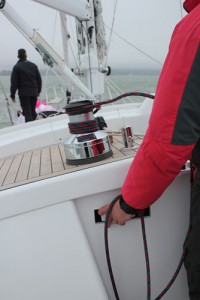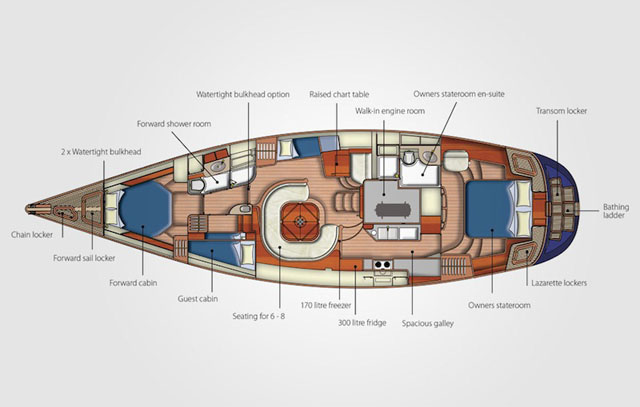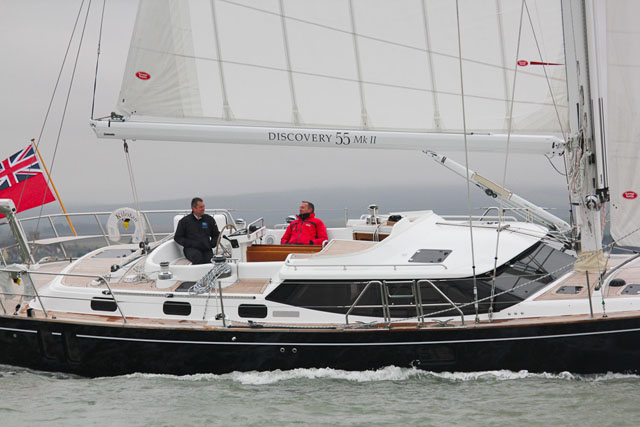Discovery 55 Mk II: Sailing into the Future
The Discovery Mk II shows that evolution in a sailboat can create new desire for an existing model.
June 8, 2015
The original Discovery 55 Mk ll was designed over a decade ago, but now that it's 2015, some serious evolution can be seen in this sailing yacht. For a more in-depth look at the builder read Discovery Yachts: A British Boat Builder on the up; for a more in-depth look at the new 55 Mk II, read on.
What's new?
Many small changes have been incorporated in the 55 over the years, although the change that led to the Mk II came with the production of a new one-piece deck that gives more contemporary, sleek styling to the deck saloon’s coach-roof, along with the adoption of flush-deck hatches. This includes narrower mullions, but retains the opening forward windows that let in cool breezes when at anchor.
Another trademark Discovery feature retained in the new model is the watch-keeper’s station, just inside the companionway. This gives a clear 270-degree view around each side of the boat and ahead. Even when heeled over, it’s possible to see the horizon on the lee side.
Down below
The interior details in this sailboat can be specified by the owner, although the layouts tend to remain the same: a large owner’s suite aft, a sizeable galley, and a big deck saloon that incorporates the navigation and watch-keeper’s station. Forward of the mast there’s a double guest cabin, plus a Pullman twin berth cabin, and either a head compartment or the option of a second large guest suite.
Another change on the new boat is the addition of two vertical hull windows in the owner’s cabin, which was made possible by advances in technology. Discovery has also improved the custom interior joinery thanks to the application of a new five-axis CNC router. The owner of the first Mk II opted for a more open saloon layout than Discovery’s usual, but none of the trademark Discovery features, including the raised deck saloon seating and easy three-step companionway, have been compromised.
Our test boat had a light maple interior, although cherry and oak are also offered as standard alternatives, with a wider range of timber offered as options. Owners are encouraged to talk directly to the teams that will be building their boats, and to discuss different possibilities with the joiners making the furniture.
The narrow linear galley, which has deep fiddles on the countertops, is ideal for use at sea. The refrigerator and freezer are located at the forward end to minimize the ‘excuse me’ factor when crew want to get drinks or snacks.
Excellent stability
The new boat retains the original Ron Holland-designed hull, which was conceived to provide a comfortable motion at sea along with easy handling and good speed. It’s fine in the ends, with the weight of major systems concentrated as much as possible in the center of the boat, and benefits from a low center of gravity bulb keel with (by today’s standards) a reassuringly high ballast ratio of 42 percent. The upshot of this is a sailboat that doesn’t pitch up and down unduly in a head sea, and has excellent stability.
Despite Discovery’s willingness to incorporate the owners’ wishes into a new boat, they report that few clients specify changes to the deck layout. The biggest differences between individual boats are in whether or not electric furling is requested, whether there’s a spinnaker/gennaker, and in the choice of cloth for the genoa, self-tacking jib and mainsails. The consistency in the deck layout is testament to the thought, planning and depth of knowledge that went into the original design.

Single or shorthanded sailing is easy, and on our test boat, it was push-button sailing at its best.
Sails and wheel choices
While I would have liked to have seen a higher specification of cloth than the Dacron the owner of our test boat had specified, I couldn’t fault the set-up in any other way. With the optional electric furling fitted it was push-button sailing at its best. With the autopilot steering the boat, no operation, whether setting sail, reefing or tacking, needed more than one person on deck.
The twin headsail rig with a self-tacking blade jib and a large overlapping genoa proved to be a very adaptable setup. It allows for easy running downwind under twin poled-out headsails in tradewind conditions, while also offering efficient options for a variety of reaching and close-hauled wind angles. This means the biggest option is whether to include asymmetric and/or symmetric spinnakers for light air running and reaching wind angles, with around half of the owners opting for such a sail.
Our test boat was fitted with a small-diameter wheel, although larger folding options are available. The smaller one proved entirely adequate, allowing a good view of the luff of the self-tacking jib while maximizing cockpit space, making it a good choice for a long-distance boat that will be predominately steered by the autopilot.
The size and displacement of the Discovery 55 Mk II means that by its very nature this is a powerful boat. That power is tamed by the sail-handling systems, although you’d need to be sure that the crew is well-versed in winch discipline as the loads in the lines could easily be underestimated.
Other options
Discovery owners tend to get involved in terms of interior finishes and the detail of the joinery, but a relatively short options list is a reflection of the high level of standard equipment. For instance, diesel generators, heating and air conditioning, electric winches, and washer/driers are all fitted as standard.
| Specifications | |
|---|---|
| Length | 55'7" |
| Beam | 15'6" |
| Draft (standard/shoal) | 7'2"/5'9" |
| Sail area | 1238 sq. ft. |
| Displacement | 49,604 lbs |
| Fuel capacity | 352 gal. |
| Water capacity | 266 gal. |
Attention to detail, a simple and efficient deck layout, and a superb interior are all key Discovery attributes. But the company’s ethos of producing boats optimized for long-distance sailing—crewed only by the owners—continues long after each boat leaves the factory.
There are two compromises, however, that spring immediately to mind: first, any yacht offering this amount of space, comfort, power and ease of handling is a complex one. That has a knock-on effect in the amount of maintenance needed and can mean more work and expense than a boat that's less complex. Secondly, building a boat to such a high standard is not a cheap process. As a result, there are mass-produced boats of a similar length that are significantly less expensive—although there’s no guarantee they'll be easier to look after in the long term.
Other Choices: The Dufour Grand Large 560 provides an option with a separate crew's quarters, for those who like having a professional or two aboard. Those who desire a modular interior that can be changed to taste should look at the Beneteau Oceanis 55.
Discovery Yachts are available in the US via factory-direct contact. For more information, visit Discovery.






















